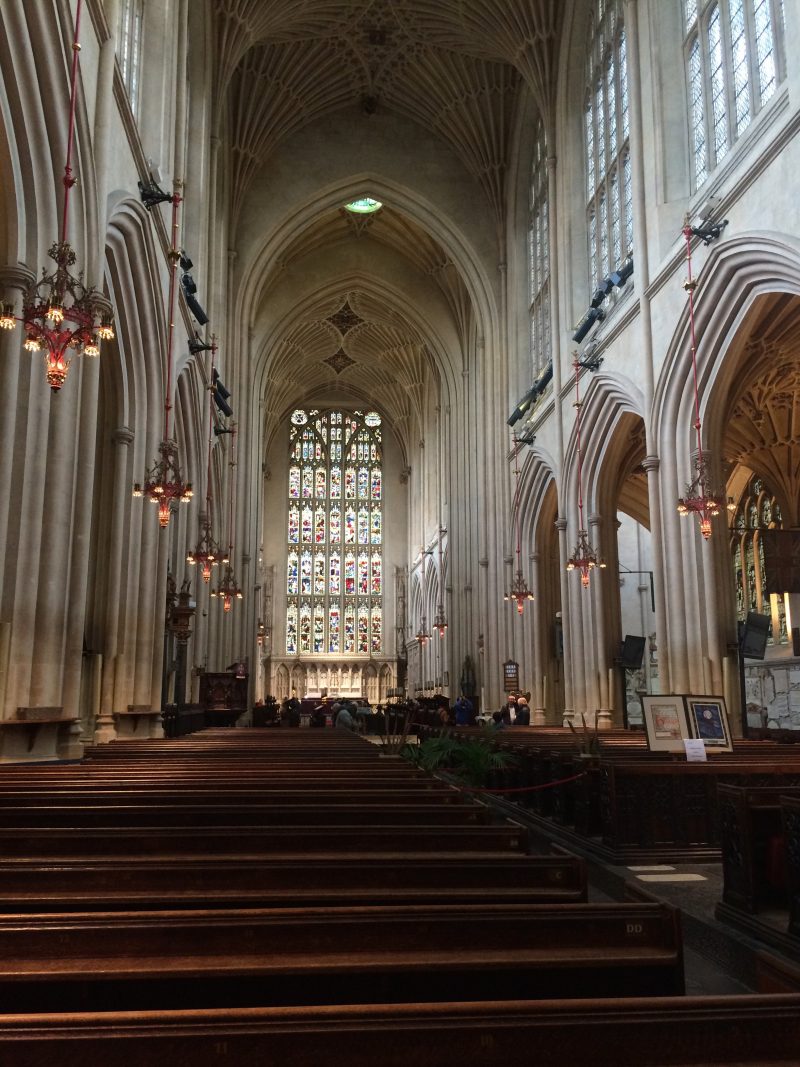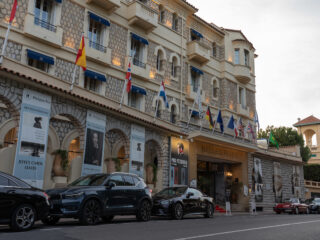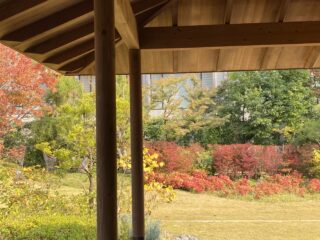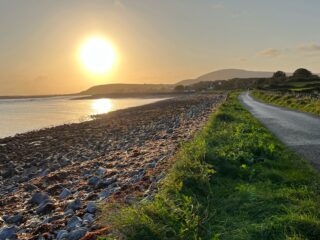By Rhea C Dhanbhoora
Bathed in gold and rich with history, this pedestrian-friendly city in Somerset, a UNESCO World Heritage Site tucked away in the valley of the River Avon, is a sensory treat for tourists.
It’s a crisp March morning but from where I stand, everything is bathed in gold tones and a surprisingly pleasant, briny bouquet wafts in and out as the wind changes, reminding me of sun and sand even though it is not summer and this is not a beach town. I am distinctly aware of every switch in the direction of the wind because it is a somewhat blustery day that threatens to ruin my touristy trudge around town. However, the chill dissipates as soon as I begin my walk, armed with a map I cannot really read and shielded from any sultry sunlight by generous cloud cover that helps soak the already sentimentally structured city in sepia tones.
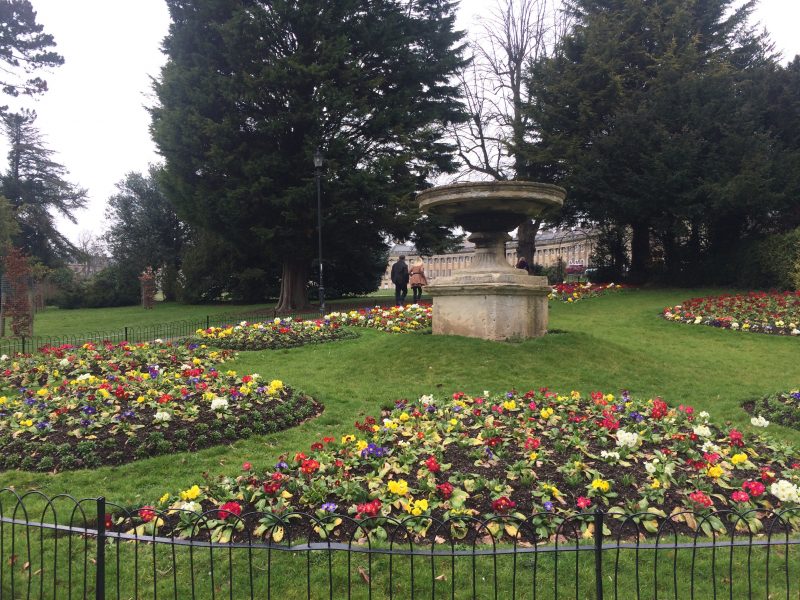
The famous Bath Stones piled one on top of the other to make each structure are even more impressive when you step up to the celebrated Georgian architecture up close — the classical facades of the abbey, the impressive pillars of the reconstructed baths, the terraces run over by colourful creepers in Queen Square, the house-fronts of the awe-inspiring Royal Crescent, which is what I’m staring up at as I take a little break on a slightly damp bench in Royal Victoria Park — it’s all doused in syrupy nostalgia, and even more so for me because I am finally walking the streets of so many of the books that shaped my reading experiences as a child.
Ever since my introduction to Bath in Chaucer’s Canterbury Tales, I’ve been captivated by the city that has drawn tourists like bees to honey for centuries, but when I am finally on my way in, I’m worried it will involve some discarding of my rose-tinted glasses. I tell myself that it will be enough just to be walking the same cobbled streets as Jane Austen, looking upon the same stretches of green as Charles Dickens, seeing the sights that inspired Richard Brinsley Sheridan… I know the minute I am there that this pep talk was not necessary because it is all just as striking as I’ve spent years imagining it would be.
In fact, the picturesque place, with it’s largely pedestrian-only streets and stunning Tudor marvel that is Bath Spa Station, is at times so overwhelming I spend a little too much time walking slowly past the sights and sounds and miss visiting the Jane Austen Centre before closing time. If you’re staying longer than I did and like me, spend most of your budget on bits and baubles from the sites you visit, make sure you get here before 4pm to make it into the gift shop. This doesn’t really affect my visit because even just walking between the imposing colonnades on Bath Street, which is like stepping straight into the 18th century, would have been enough. Of course, that’s not all I do.

After a two and a half hour car ride from London, I’m in Bath too late for breakfast and too early for lunch, but I’m lucky enough to turn a street corner close to the famous Bath Abbey that leads me to Sally Lunn’s Bunn, the oldest house in Bath (1482) and home of the world famous Sally Lunn bun — I don’t know what that is but the minute I take a bite I’m glad it exists–a large, soft bun that’s served with all sorts of toppings. I sample the salt beef and smoked salmon, both delectable creations, but if you’re looking to really sample the “bun that isn’t a bun” as they put it, drown it in some of their delicious flavoured butters. With that and a Golden Hare (one of the famous Bath Ales, a full-flavoured light ale that went very well with my meal) lining my stomach, I start to walk aimlessly through the streets, which if you have the time to do, is a lot more satisfying than rushing from site to site with a tourist map.
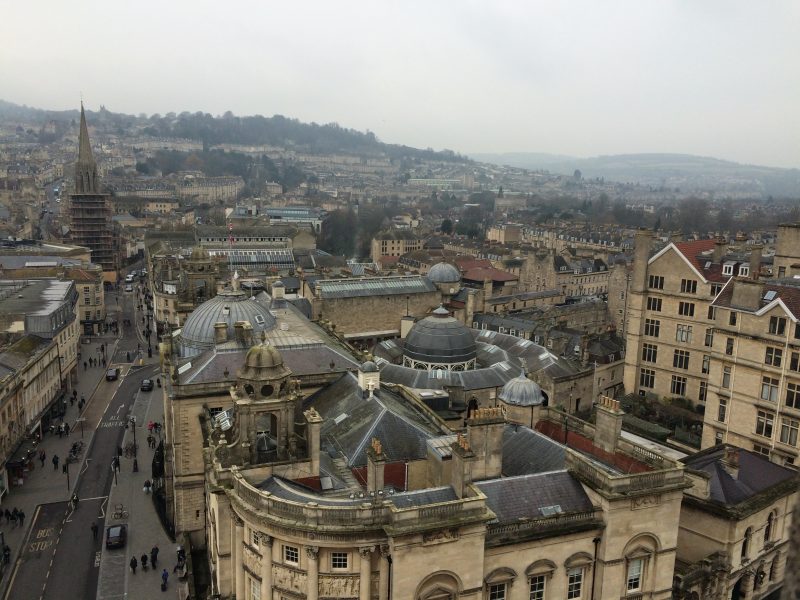
After hurrying past without a second glance in my eagerness to eat the first time around, I have to stop now and admire the awe-inspiring Abbey, which I am told by a very friendly lady inside is the jewel of the city. I can see why, staring up at the impressive vaulted ceiling as I am told its equally impressive history, from Saxon convent in 675 AD to tourist hotspot of the 21st century. I am just in time for a tour to the top of the Tower, which is 212 steps (pretty high ones too, if you’re also very short) up to the ringing chamber where you’re told about the bells and the clock and if you’re lucky, treated to some deafening sounds. The tour’s claim to fame though, has to be the view from the top: a breathtaking sweep of the city from an unrivaled vantage point.
Bath is a city deserving of dawdlers, who can soak up the spectacular street corners, drink in a little of the honey hues that the buildings lend an endearing gleam of antiquity to the most commercial areas, like Milsom Street, a name I remember thanks again to Jane Austen.
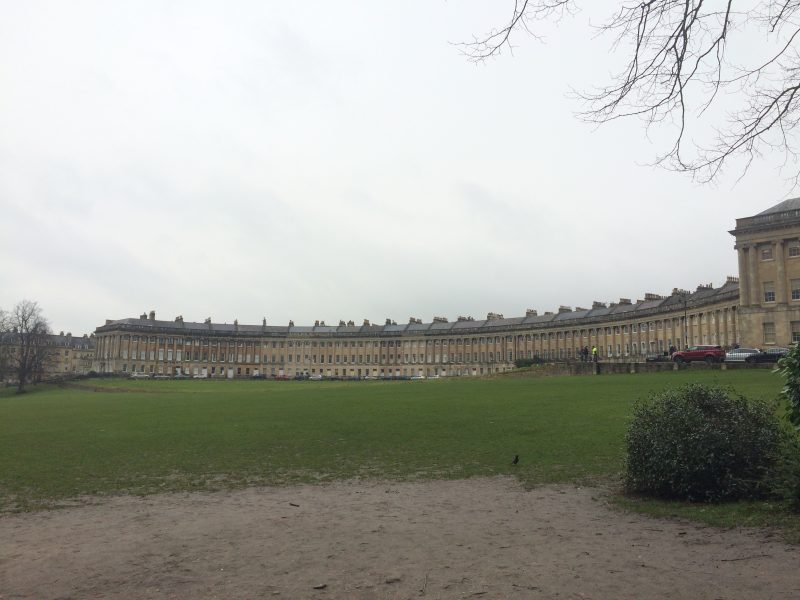
I stroll over to survey the houses on Camden Crescent since I am told they are prime real estate, even though part of me is thinking I want to breathe in the scent of flowers springing up in rainbow clusters to welcome the season and step over the well-manicured lawns of the gardens, not look up at some stodgy buildings arranged in a crescent. Standing in front of what is truly masterful architecture, I am glad to have been proven wrong and am fascinated by such small things as doorway keystones on these stunning structures. I walk away somehow enriched by the view, of and around the crescent. I am told the panoramic views from inside the period lodging are just as wonderful.
Classic literature, snapshots of Georgian life, regal tidbits… it’s all wonderful but even if what you’re really looking for is a place to splurge, Bath isn’t going to disappoint. It may not be the shop-a-minute city that London is, but at SouthGate, there’s everything from Debenhams and Topshop to H&M. More interesting to me is Guildhall Market, where I find myself among an array of little shops selling everything from antiques to cheese. I also have to stop myself from filling my handbag with too much of the mouth-watering selection of cheeses (they say they are Britain’s oldest cheesemonger, so step in for a slice of history even if cheese isn’t really up your alley) from Paxton and Whitfield. I am told later that I should have walked through Artisan Quarter, but even in my disarray I have certain things I need to check off my list before the sun sets, which it does early in March so I have to try and shield my eyes from the charming vendors and quaint shop fronts. I also skip the Fashion Museum, but if you’re dying to see some 18th century attire, or want to step into another Austen novel in the Assembly Rooms above the exhibit, this is a good place to stop.
A quick walk away from Guildhall Market is The Old Green Tree Pub, which I cannot resist stepping into for some ale and a quick bite; the prawn cocktail crisps and maltesers I’ve been pocket-snacking on through the day have not done enough to keep my hunger at bay and I need more fuel before I skip off to see what else Bath has to offer. This is the perfect place for a pitstop if you’re hoping not to break the spell of traditional old English charm that the city wraps you in, because everything from the old-world tavern ambience and wood panelling to the large, very satisfying selection of ale and friendly service are top notch. Unfortunately their food is on a lunch-only menu and I am forced to dip into mypockets for more crisps and chocolate after I’ve knocked back two beers and started off on to the next spot. However, once I arrive, I’ve completely forgotten about any griping frommy near empty stomach..
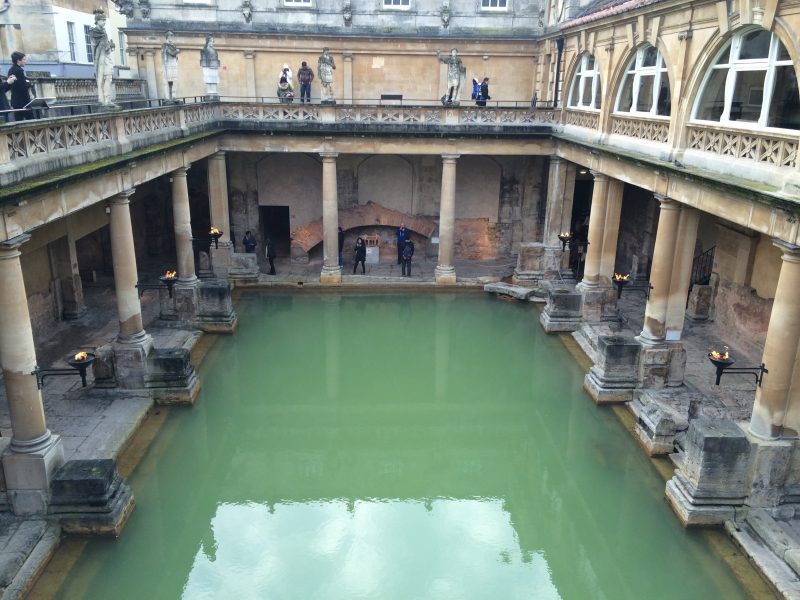
A hop, skip and jump away from the charming pub is what some would call Bath’s chef d’oeuvre, the Roman Baths that have been the pièce de résistance for tourists from all over the world, and most definitely one of the city’s most recognisable landmarks. The stunning archeology surrounding the Baths are worth visiting if only because they are preservations of real Roman remains, from the temple of the Goddess Sulis Minerva to the walled settlement called Aquae Sulis, which, as a placard tells me, was built by Roman architects and craftsman and was a space first visited by Roman soldiers, then inhabited by people from local tribes, officials and priests as well as traders from across the Empire. There’s even a model settlement encased in glass so you can see what it probably looked like back in the day.
The audio guide in my ear tells me that the city got much of its supply of hot water from these Baths, where rain once sank (a long, long time ago) a mile and a half below the ground and was heated up to a whopping 46C (that’s around 113F) by the rocks. Also underground is the Beau Street Hoard, around 17,577 Roman silver coins that were found buried in the corner of a building close by. Learning about the ancient aqueduct systems and geothermal energy that heats up the water is intriguing, as is seeing the Roman drain, the public baths underground, high Roman Roof and the underground canals that include the Sacred Spring Overflow, from which surplus water flows into a river. However, Bath’s Hot Springs have been on my list for almost as long as the city itself, so I’m almost skipping with excitement as I walk over white and black checkered marble, stopping only to admire the sweeping arches and the stone statues framing the reconstructed top half of this quadrangle structure that looks more Greek than Roman to me until I’m inches away from the hot water of the thermae, surrounding myself by the imposing pillars I have up to this moment, only ever seen in pictures.
Resisting the urge to dip my fingers in the moss green water, watching layers of steam swimming over the top and rising up to dance with the clouds, I breathe in the very peculiar and mostly indescribable scent of these hot springs, one of three main springs through which I am told several hundred thousand gallons of water flow through on a daily basis. It is louder than I think it will be, and the marble surrounding the bath is cold even though the steam from the hot bath is warming up the air around it. I sit there for longer than a tourist usually would, catching the odd suspicious glance from security stationed around to make sure people don’t dunk their hands and feet into the water, but mostly too lost in thought to notice. Because it is March, which is not a heavy tourist season, I have most of this hot spring to myself and there’s a chill in the air that makes it easy to stand so close to the rising steam without feeling suffocated by the heat it is emitting. Looking down into the opaque jade liquid I understand how simply being in this city a while was stimulating enough to be where Mary Shelley wrote most of Frankenstein, which a plaque and information board outside the Baths will proudly tell you.
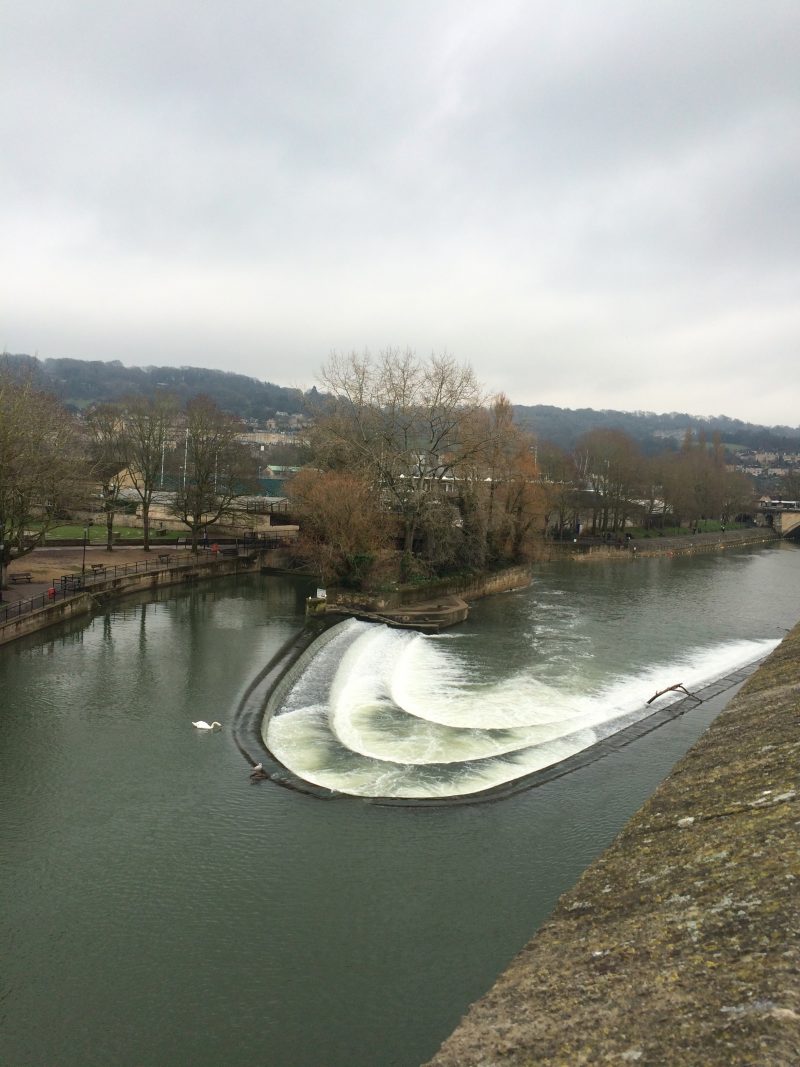
It is almost as satisfying, a few minutes later, to be looking down off the limestone edges of Pulteney Bridge into the concentric oval streams of water rushing down the River Avon.
For a last meal before I have to turn my back on a city I wish I had planned to spend more than one day in, I find myself in The Bath Brew House, digging into salt and pepper squid, a braised pork belly and a sticky toffee pudding that I wash down with some beer.
A few minutes into the car ride home my head is already buzzing with inspiration, ready to write my own Frankenstein. I expected nothing less, but I am still somewhat spellbound by how much I was able to soak up even with my slow ambles, pitstops and small time frame. I reflect on how wistfully reminiscent of a childhood spent with my nose in a novel I became just by simply walking the streets of Bath..
Rhea C Dhanbhoora has over seven years of experience as a writer and editor with print and digital media and over a decade as a freelance writer. More specifically, she has spent several years reviewing travel hot spots, writing travel guides, articles, and essays and consistently writing and managing a travel page for a daily newspaper. You can follow her work at www.rheadhanbhoora.com.

